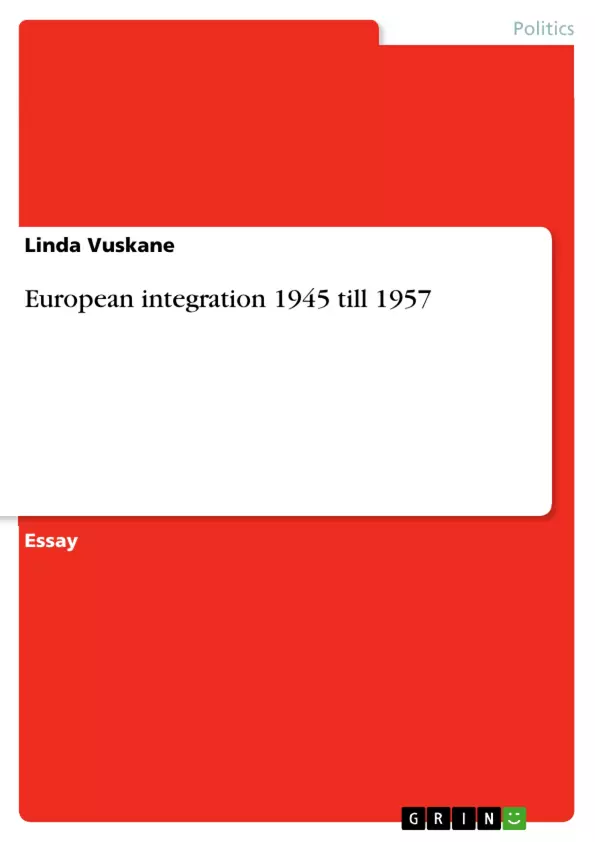In general the primary factors contributing to European integration were largely political and ideological. It was the French wariness of the Germany, the Western, most notably US, fear of Communism and Germany’s will to be accepted again that drove the integration forward. Nevertheless, for most countries the economic component was if not primary then still essential. Moreover, many of these factors are overlapping and interrelate with each other.
Although the impetus from various committed individuals played a crucial role, the European integration was based on a reaction to external and internal pressures rather than on inherent sense of a common European ideology and harmony.
Inhaltsverzeichnis (Table of Contents)
- The Relative Significance of International, Political and Economic Factors in Promoting Moves towards European Integration in the Period from 1945 till 1957
- The Main Priority: Preventing Future Conflicts
- The Role of the US and a United Germany
- Germany as a Potential Threat
- The Emergence of the Cold War
- Economic Arguments for European Integration
- The Marshall Plan
- The Schuman Plan
- The European Coal and Steel Community (ECSC)
- Military Integration and NATO
Zielsetzung und Themenschwerpunkte (Objectives and Key Themes)
This paper aims to assess the relative influence of international, political, and economic factors in driving the movement toward European integration during the period from 1945 to 1957. It seeks to understand how these factors interacted and contributed to the establishment of the European Coal and Steel Community (ECSC) and the eventual formation of the European Economic Community (EEC).
- The significance of international factors, particularly the Cold War, in shaping the drive for European integration.
- The role of political factors, including the need for stability and peace in post-war Europe and the management of the relationship between France and Germany.
- The influence of economic factors, such as the desire for economic recovery, the avoidance of economic nationalism, and the need to counter Soviet expansion.
- The contribution of US economic aid, through the Marshall Plan, and its potential impact on European integration.
- The importance of individual European figures and their initiatives, such as the Schuman Plan, in pushing forward the integration process.
Zusammenfassung der Kapitel (Chapter Summaries)
- The paper begins by highlighting the devastation of Europe following WWII and the urgency for cooperation. The three original priorities identified for European integration are preventing new conflicts, economic recovery, and security against Cold War threats. The specific motivations of different European countries for integration are explored, particularly highlighting the concerns surrounding Germany's potential resurgence.
- The emergence of the Cold War and the resulting bipolar world are examined as a key driver of the European integration movement. The paper analyzes the economic arguments for integration, including the desire to avoid the mistakes of the interwar period and to achieve economic recovery. However, national governments initially prioritized their own economic reconstruction over cooperation.
- The Marshall Plan is presented as a crucial factor in supporting European economic recovery and encouraging integration. The motivations behind the plan are discussed, including the US's fear of economic recession and the spread of communism. The impact of the plan on European integration is evaluated, acknowledging both its economic and psychological effects.
- The paper discusses the importance of the Schuman Plan, proposed by Jean Monnet, as a turning point in the integration process. The plan advocated for the pooling of coal and steel resources under a supranational authority. The motives behind the plan, including France's desire to control Germany and its economic interests, are explored. The plan's success in contributing to peace and international rehabilitation for Germany is highlighted.
Schlüsselwörter (Keywords)
The key terms and concepts explored in this work include European integration, Cold War, post-war reconstruction, economic recovery, French-German relations, Marshall Plan, Schuman Plan, European Coal and Steel Community (ECSC), and the role of individual figures like Jean Monnet and Robert Schuman.
- Arbeit zitieren
- Linda Vuskane (Autor:in), 2010, European integration 1945 till 1957, München, GRIN Verlag, https://www.hausarbeiten.de/document/156228


